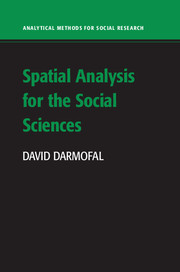Book contents
- Frontmatter
- Contents
- List of Figures
- List of Tables
- Preface
- PART I GENERAL TOPICS
- PART II ADVANCED TOPICS
- PART III APPENDICES ON IMPLEMENTING SPATIAL ANALYSES
- Appendix A Getting Data Ready for a Spatial Analysis
- Appendix B Spatial Software
- Appendix C Web Resources for Spatial Analysis
- Glossary
- Bibliography
- Index
Appendix C - Web Resources for Spatial Analysis
from PART III - APPENDICES ON IMPLEMENTING SPATIAL ANALYSES
Published online by Cambridge University Press: 05 November 2015
- Frontmatter
- Contents
- List of Figures
- List of Tables
- Preface
- PART I GENERAL TOPICS
- PART II ADVANCED TOPICS
- PART III APPENDICES ON IMPLEMENTING SPATIAL ANALYSES
- Appendix A Getting Data Ready for a Spatial Analysis
- Appendix B Spatial Software
- Appendix C Web Resources for Spatial Analysis
- Glossary
- Bibliography
- Index
Summary
Several helpful websites and listservs for spatial analysis have been developed as the use of spatial techniques has increased over the past two decades. This appendix considers some of the most helpful Web resources on spatial analysis in these two categories.
WEBSITES
AI-GEOSTATS (http://www.ai-geostats.org/): This website provides a variety of resources for geostatistics and spatial analysis. Among these are links to software, papers, books, conferences, and job openings. The site also provides links to the AI-GEOSTATS mailing list.
Center for Spatially Integrated Social Science (CSISS) (http://www.csiss.org/): Funded in 1999 by the National Science Foundation, The Center for Spatially Integrated Social Science (CSISS) (housed at the University of California, Santa Barbara) is designed to advance the dissemination of spatial techniques and perspectives in the social sciences. The CSISS website provides a variety of resources for social scientists wishing to apply spatial analysis in their research. Among these are a searchable database of more than 17,000 references featuring spatial applications in the social sciences from 1990 to 2004. The website also includes video clips of workshops, descriptions of “classic” geographically oriented studies in the social sciences, and links to software tools.
GeoDa Center (http://geodacenter.asu.edu/): Founded by Luc Anselin, the GeoDa Center for Geospatial Analysis and Computation at Arizona State University has become a leading repository for spatial studies, the dissemination of spatial software tools, and the provision of training and support. The website provides a link for downloading GeoDa and also provides tutorials for GeoDa and for spatial packages in R. The site also provides an extensive set of e-talks, lectures on spatial analysis, tools, and techniques. The website also provides links to recent working papers by scholars affiliated with the GeoDa Center as well as to spatial data that can be downloaded for analysis.
GISpopsci.org (http://gispopsci.org): This project is a collaboration between the Population Research Institute (The Pennsylvania State University) and the Center for Spatially Integrated Social Science (University of California, Santa Barbara). The site, whose development was funded in part by the Eunice Kennedy Shriver National Institute of Child Health and Human Development (NICHD), provides a variety of resources for research and instruction on advanced spatial analysis in the population sciences and spatial demography. The website maintains an extensive bibliography of citations applicable to research in spatial demography and the population sciences. The site also contains links to course syllabi on spatial topics.
- Type
- Chapter
- Information
- Spatial Analysis for the Social Sciences , pp. 215 - 218Publisher: Cambridge University PressPrint publication year: 2015

